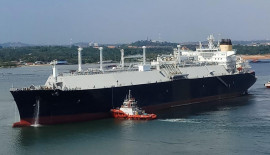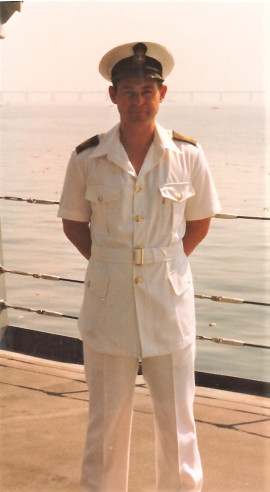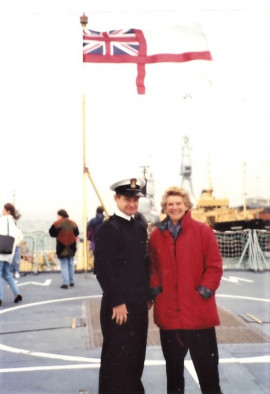 Photo 1 A Gas Injected Megi Engine Lng Tanker Entering Singapore 2021 For Refit
Photo 1 A Gas Injected Megi Engine Lng Tanker Entering Singapore 2021 For Refit Photo 7 Stuart Ramsden In Tropical Uniform As Officer Of The Day Probably Around 1994 On Hms Westminster
Photo 7 Stuart Ramsden In Tropical Uniform As Officer Of The Day Probably Around 1994 On Hms Westminster Photo 5 Stuart Ramsden And His Mother On The Flight Deck Of Hms Westminster In Pompey Harbour Around 1994
Photo 5 Stuart Ramsden And His Mother On The Flight Deck Of Hms Westminster In Pompey Harbour Around 1994
This Merchant Navy Day the Royal Naval Association honours our Merchant Navy shipmates
This Merchant Navy Day, Sunday 3rd September we honour and remember our Merchant Navy Shipmates. Merchant Navy Veterans who are holders of the Merchant Navy Association Veterans Badge are eligible and very welcome to join the Royal Naval Association.
Some of our Shipmates have served in both the Royal Navy and the Merchant Navy; Stuart Ramsden from our Eastbourne Branch tells us his story:
“Having been born in Eastbourne and spent all of my younger years by the sea, at the outset, all I ever wanted to do was to go to Sea to work.
Stuart spent 22 years in the Royal Navy, his last ship was HMS Westminster (Type 23 Frigate) which he joined as the first Charge Chief MEA (CCMEA), just after it had completed post Build Sea Trials in July 1994.
He left the RN in 1997 and by a happy accident joined Oil Major as an engineer on their managed Ships.
“I worked on all sorts of Tankers, Very Large Crude Carriers VLCC’s, Product tankers (carrying refined fuels) and finally on Liquid Natural Gas (LNG) Tankers.
“One highlight was as Chief Engineer delivering in to service one of a number of LNG Tankers Known as Q Max Tankers which were and are the biggest in the world, from the Korean builders yard, vessels which on a number of occasions delivering LNG to the UK.
“Working in the MN gave me a varied and interesting job. In the RN I was mainly involved in the marine engineering. In the MN especially as a Chief Engineer, my job was much more varied; I was involved in the engineering, Cargo operations and Radar and radio/comms equipment maintenance and repair. I was also responsible for ordering the spares and stores, fueling the vessel and arranging for external specialist contractors when needed.
“I travelled all over the world to many different Ports, such as Korea, Japan, China, Taiwan, Singapore, Durban and Ports in New Zealand, Australia and the Gulf States. In 2000 my wife decided to try a trip at sea with me as you can in the MN, and continued to accompany me for the next 15 years or so. I worked with seafarers from many different countries and cultures, which is always enriching, and consequently have many good friends across the world.
“In Sept 2015 I came ashore into the Company Headquarters and became an Engineer Superintendent, managing the types of vessels that I had recently sailed on. Two highlights, in 2017 through 2018 I led the team that delivered 5 new LNG Tankers into service for our company again from Korean Dockyards, these were some of the newest vessels around at the time, using the LNG Boil off Gas to power the Diesel Engines, extremely clean burning. Then just recently in 2021 and 22, I again led the teams that managed the refits of these same five vessels in the Singapore Refit Yards.
Stuart tells us why it is so important to recognise the Merchant Navy: “I think most people who know their history are well aware of the sacrifice that Merchant Seaman made during the convoys of the Second World war.
“I don’t think many know that there are 10’s if not 100’s of thousands of Merchant Mariners at sea on any one day. People do not realise that virtually everything that they eat or buy, dry goods, cars, fuel etc are transported by sea and Merchant seafarers go unrecognised until things go wrong.
“It still remains a hard and hazardous job, as in the RN, it involves months at a time away from families, this was exacerbated during the pandemic when, many personnel who were at sea at the time suddenly found they could not get relieved with flights shut down and many ports not allowing personnel in or out. Personnel were spending upwards of 6 to 9 months on the vessel when it should be 3 or 4. It was an extremely difficult time for not only the seafarers but also companies as we tried everything possible to get personnel relieved.”